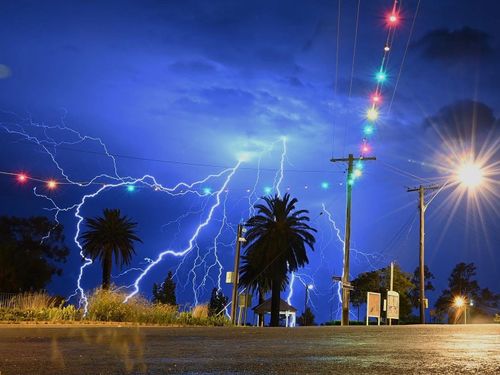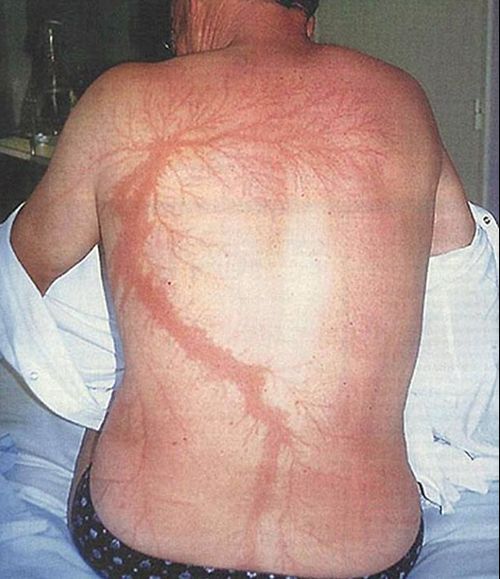
An ominous-looking storm was rolling in when Kristoffer Green and his family pulled up at an Ipswich medical centre in Queensland.
It was November 2015 and Green's young daughter had a wasp bite he and his wife wanted a doctor to take a look at.
"We saw the dark clouds and we said, 'Oh, we better watch that'," the father-of-two, 31, told 9news.com.au.

Green thought nothing more of the storm until they were leaving the medical centre in the pouring rain.
"I was helping my wife get my daughter in the backseat of the car and I was holding an umbrella," Green said.
"The umbrella had a wooden handle, but the tip of my right index finger was resting on the metal pole in the centre."
Green said he remembers almost nothing of the moment the lightning bolt struck, hitting the metal top of his umbrella, travelling down its shaft and up his index finger into his arm.
"It was just like a blinding light and then I blacked out," he said.
"My wife said I just simply collapsed."
Thinking fast, Green's wife raced into the medical centre to get help from staff.
"When I woke up in the medical centre my wife was crying over me and I was just completely shocked. I had no idea where I was or what had happened," he said.
Medical centre staff had hooked Green up to a monitor, which showed his heart was racing "a million miles an hour", he said.
The young dad, who was 24 at the time, was taken by ambulance to Ipswich hospital for monitoring before being sent home the next day.
Every year, around five to ten Australians are killed by lightning strikes and 100 injuries are reported, according to the Bureau of Meteorology.

Green is one of the lucky majority to survive a lightning strike.
But the effects, both physical and psychological, would linger for him.
For days after the strike, Green said his right arm would not stop tingling.
Green went from liking storms and taking pleasure in watching the lightning dance across the sky, to having an extreme aversion to the weather phenomenon.
"If there was a storm, I would get stressed and have heart palpitations," he said.
Green claims he even developed a sort of internal barometer of his own, which alerted him if a storm was approaching.
"For a few years after the strike, my right arm - where the lightning went through - would tingle and start to hurt before a storm was overhead.
"I even sometimes still do it. I'll say to my wife, 'There's a storm coming, hun' and sure enough, a few hours later, there's a storm coming in."
Smells of 'burning flesh and hair'
Far North Queensland man Sol Daley was out on the front verandah watching a storm on his rural property in Innisfail in 2016 when he was hit by a lightning bolt.
"My partner at the time was in the front yard moving pot plants around," he said.
"Funnily enough, I said to her, 'Get out of there because there's lightning about'.
"As she stepped on the verandah, 'bang', the lightning hit."

Daley was sitting on an aluminium chair.
"It was like a big blue finger and it came across, went through my arm and came out my foot," he said.
"All I remember was the incredible bang, the flash of light and it was like someone was trying to kick their way out of my chest and between my legs.
"There was a smell of burning flesh and burning hair."
Daley spent a day at Innisfail Hospital before being sent home.
But it soon became apparent that his recovery would not be straightforward.
"The next day I woke up, and I felt sort of felt okay, but when I went to speak, I couldn't. My words were all mixed up like I had a stroke," he said.
Daley said his speech issues continued for about a month, along with other symptoms.
"I was getting scrambled thoughts and I used to get the shakes, I called it the electric boogaloo."
Lightning does strike twice
Julie Martineau, from Iowa in the US, is living proof that the old idiom "lightning doesn't strike twice" has no basis in fact.
The first time Martineau was hit was back in 1999 when she was living in a mobile home.
It was the evening, a storm had blown up and she was doing the laundry.
As Martineau put her hand on the clothes dryer door, a bolt of lightning missed a large tree overhanging her mobile home and shot down the wiring connected to the dryer.
The electric current entered Martineau's right hand, travelled across her chest and exited through her left hand.

"I remember everything," she said.
"I remember the bolt striking, I remember the crackle of the bolt coming down and feeling like time stopped.
"I could hear my heart beating and counting the heartbeats and thinking 'Holy crow, there's something really wrong' and trying to let go of the dryer and I couldn't let go, the current was holding me in place."
Martineau said for months after the lightning strike she suffered a range of debilitating health effects, some of which still plague her today.
"I had a lot of pain, mainly in my arms. There was some confusion, some irritability, some personality changes, but the big one was that I couldn't sleep."
Just over a year later, in October 2000, Martineau had moved from her mobile home after buying a house.
It was night-time and a storm was raging outside.
"I was asleep, lying in a waterbed and somehow a bolt came in through the second-storey window," she said.
"My bed was maybe (a few metres) from the window and the bolt came in through the window and basically flashed over the bladder for the waterbed.
"It kind of flashed over that and caught me in the process, I was collateral damage."
Firefighters share photos of inferno threatening homes
Martineau has since started up a Facebook support group for lightning strike survivors.
A Native American, Martineau said she sought answers during a traditional ceremony about her two painful lightning experiences and had found peace in the belief the spirits had chosen her.
How to keep safe in a storm
Every day, there are as many as 8 million lightning strikes globally, with around 44 strikes recorded per second at any one time.
In Australia, Darwin is the thunderstorm capital, with over 80 thunderstorm days per year.
So what can you do to keep safe during a storm? Here are some of the Bureau of Meteorology's top tips:
Stay inside and shelter well clear of windows, doors and skylights
Don't use a landline telephone during a thunderstorm
Avoid touching brick or concrete, or standing barefoot on concrete or tiled floors; and
Keep checking the Bureau's website or app and listen to your local radio station for storm warnings and updates.
For Davey, it all comes down to taking care and using common sense.
"Don't think you're too good and that it's not going to happen because it can happen in a heartbeat," he said.





